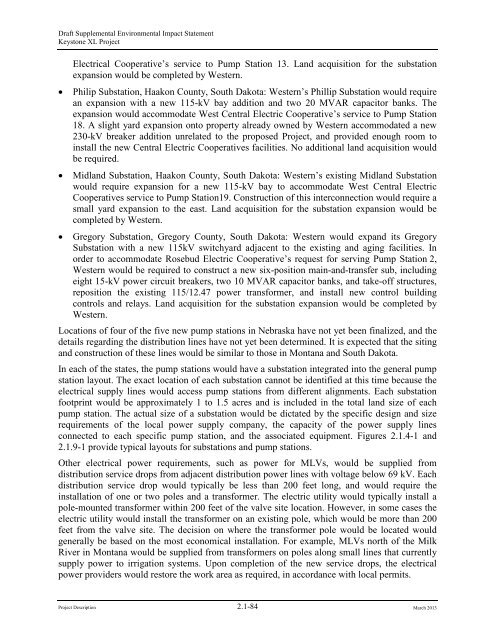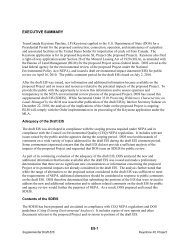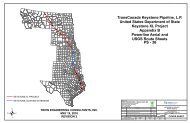2.1 Overview of the Proposed Project - Keystone XL pipeline - US ...
2.1 Overview of the Proposed Project - Keystone XL pipeline - US ...
2.1 Overview of the Proposed Project - Keystone XL pipeline - US ...
Create successful ePaper yourself
Turn your PDF publications into a flip-book with our unique Google optimized e-Paper software.
Draft Supplemental Environmental Impact Statement<strong>Keystone</strong> <strong>XL</strong> <strong>Project</strong>Electrical Cooperative’s service to Pump Station 13. Land acquisition for <strong>the</strong> substationexpansion would be completed by Western.• Philip Substation, Haakon County, South Dakota: Western’s Phillip Substation would requirean expansion with a new 115-kV bay addition and two 20 MVAR capacitor banks. Theexpansion would accommodate West Central Electric Cooperative’s service to Pump Station18. A slight yard expansion onto property already owned by Western accommodated a new230-kV breaker addition unrelated to <strong>the</strong> proposed <strong>Project</strong>, and provided enough room toinstall <strong>the</strong> new Central Electric Cooperatives facilities. No additional land acquisition wouldbe required.• Midland Substation, Haakon County, South Dakota: Western’s existing Midland Substationwould require expansion for a new 115-kV bay to accommodate West Central ElectricCooperatives service to Pump Station19. Construction <strong>of</strong> this interconnection would require asmall yard expansion to <strong>the</strong> east. Land acquisition for <strong>the</strong> substation expansion would becompleted by Western.• Gregory Substation, Gregory County, South Dakota: Western would expand its GregorySubstation with a new 115kV switchyard adjacent to <strong>the</strong> existing and aging facilities. Inorder to accommodate Rosebud Electric Cooperative’s request for serving Pump Station 2,Western would be required to construct a new six-position main-and-transfer sub, includingeight 15-kV power circuit breakers, two 10 MVAR capacitor banks, and take-<strong>of</strong>f structures,reposition <strong>the</strong> existing 115/12.47 power transformer, and install new control buildingcontrols and relays. Land acquisition for <strong>the</strong> substation expansion would be completed byWestern.Locations <strong>of</strong> four <strong>of</strong> <strong>the</strong> five new pump stations in Nebraska have not yet been finalized, and <strong>the</strong>details regarding <strong>the</strong> distribution lines have not yet been determined. It is expected that <strong>the</strong> sitingand construction <strong>of</strong> <strong>the</strong>se lines would be similar to those in Montana and South Dakota.In each <strong>of</strong> <strong>the</strong> states, <strong>the</strong> pump stations would have a substation integrated into <strong>the</strong> general pumpstation layout. The exact location <strong>of</strong> each substation cannot be identified at this time because <strong>the</strong>electrical supply lines would access pump stations from different alignments. Each substationfootprint would be approximately 1 to 1.5 acres and is included in <strong>the</strong> total land size <strong>of</strong> eachpump station. The actual size <strong>of</strong> a substation would be dictated by <strong>the</strong> specific design and sizerequirements <strong>of</strong> <strong>the</strong> local power supply company, <strong>the</strong> capacity <strong>of</strong> <strong>the</strong> power supply linesconnected to each specific pump station, and <strong>the</strong> associated equipment. Figures <strong>2.1</strong>.4-1 and<strong>2.1</strong>.9-1 provide typical layouts for substations and pump stations.O<strong>the</strong>r electrical power requirements, such as power for MLVs, would be supplied fromdistribution service drops from adjacent distribution power lines with voltage below 69 kV. Eachdistribution service drop would typically be less than 200 feet long, and would require <strong>the</strong>installation <strong>of</strong> one or two poles and a transformer. The electric utility would typically install apole-mounted transformer within 200 feet <strong>of</strong> <strong>the</strong> valve site location. However, in some cases <strong>the</strong>electric utility would install <strong>the</strong> transformer on an existing pole, which would be more than 200feet from <strong>the</strong> valve site. The decision on where <strong>the</strong> transformer pole would be located wouldgenerally be based on <strong>the</strong> most economical installation. For example, MLVs north <strong>of</strong> <strong>the</strong> MilkRiver in Montana would be supplied from transformers on poles along small lines that currentlysupply power to irrigation systems. Upon completion <strong>of</strong> <strong>the</strong> new service drops, <strong>the</strong> electricalpower providers would restore <strong>the</strong> work area as required, in accordance with local permits.<strong>Project</strong> Description <strong>2.1</strong>-84 March 2013











